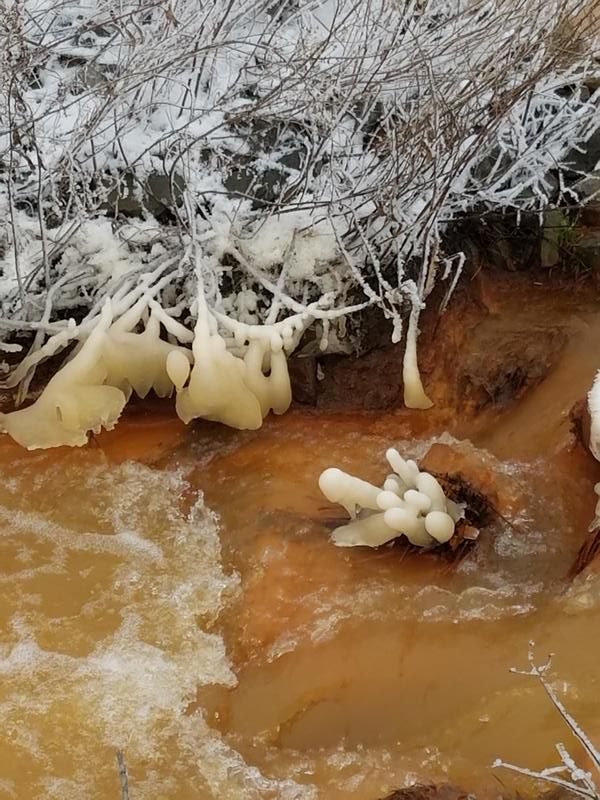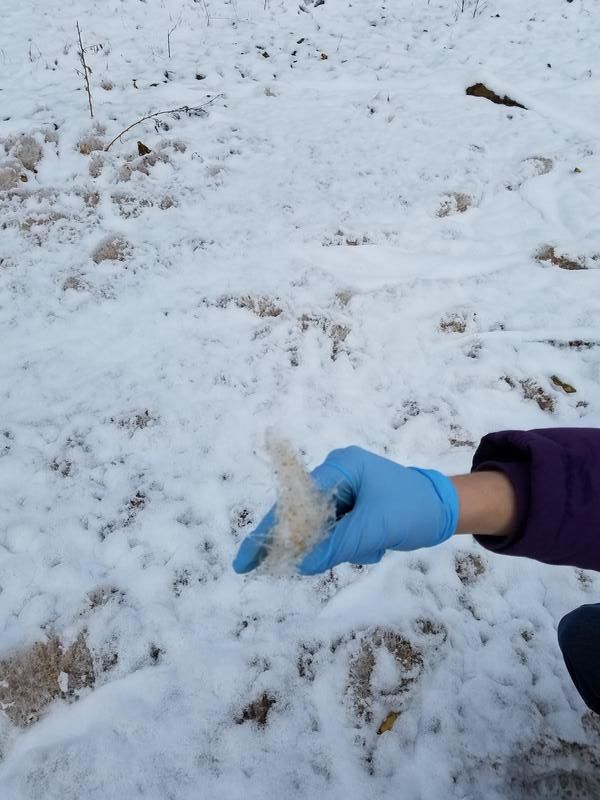|
There is something so beautiful about an early morning following a winter snowfall. There is a sense of purity, for a few moments everything is new and untouched. The air appears cleaner and the world seems still. As Elizabeth Cochran, a masters student in my lab, and I approached Lowber I got a sense of peace, the remediation site had transferred from a place of destruction to a place of beauty overnight. Thats not to say that the devastation that was happening to the land was forgotten (the orange ponds were still prominent), but for one moment the land was once again beautiful, it was breathtaking. Lowber passive remediation system in Lowber, PA (Winter 2018) Picture taken in one of the troughs between the ponds We started at the effluent of the system, the end of the wetlands, and worked our way forward. The wetlands was primarily frozen, but there was still water flowing through a narrow path. It made me wonder if the water was flowing underneath the ice or if water flow was truly limited to a narrow path all year. I think a dye test may be in order this summer to test the water flow from influent to effluent. In the mean time, the water was muddy and not very clear. Elizabeth taking field measurements in the wetlands (effluent) Frozen wetlands Lowber now showing its rendition of Swan Lake After we sampled 6 liters of water/soil slurry, took field measurements, and freed a cattail from a block of ice, we moved to pond 3. Pond 3 is in the middle of the remediation system and we often study this pond because it serves as a potential inflection point (where contaminants and microbial communities shift). Pond 3 had no ice at all and was six degrees warmer than the effluent. This is to be expected, as the first couple ponds typically don't freeze because the mine discharge is from an underground mine and so it comes into the system fairly warm all year round. There was a few biofilms present as well. Another 6 liters of slurry was collected and Elizabeth found another interesting plant to sample for iron accumulation around the roots. Pond 3 with no ice Biofilms found in Pond 3 Here I am taking field measurements in pond 3 Our last stop was pond 1 where another 6 liters of slurry was collected and field measurements were taken. Pond 1 is the first settling pond of the system and was even warmer than pond 3 (~3 degrees warmer). There was a large manganese sheen at the influent of pond 1, suggesting the presence of leptothrix. There was also extensive biofilms growing around the edge of the pond. There was visible bubbles coming from the biofilms. There was a a distinct smell of "rotten eggs", the classic description of sulfide, present at this pond, where the other ponds lacked this lovely smell. Pond 1 and its massive manganese sheen Biofilm formation in pond 1, note the bubbles coming up to the surface As we were walking past the giant mound of iron hydroxide that had been drudged from the ponds (that was now covered in snow), we noticed that there were crystals forming in the snow. Though I cannot explain what was causing this crystallization, it was really cool seeing them laying in the snow! It just confirmed the beauty that had formed at Lowber that cool winter morning. Crystal formation on top of the iron hydroxide that had been drudged from the ponds close up of the crystals The samples collected on this trip will be used for enrichment cultures and lab-based studies to identify bacteria that may serve as bioindicators, as well as bacteria that may be resolubilizing contaminants in the system. mRNA will also be sequenced to track changes in metabolic genes, that could later be used to identify changes/shifts in the system.
1 Comment
|
Michelle ValkanasI will blog here about research excursions, community outreach, and other exciting science events Archives
March 2019
Categories |
Copyright © 2024 by Michelle M. Valkanas. All rights reserved.












 RSS Feed
RSS Feed